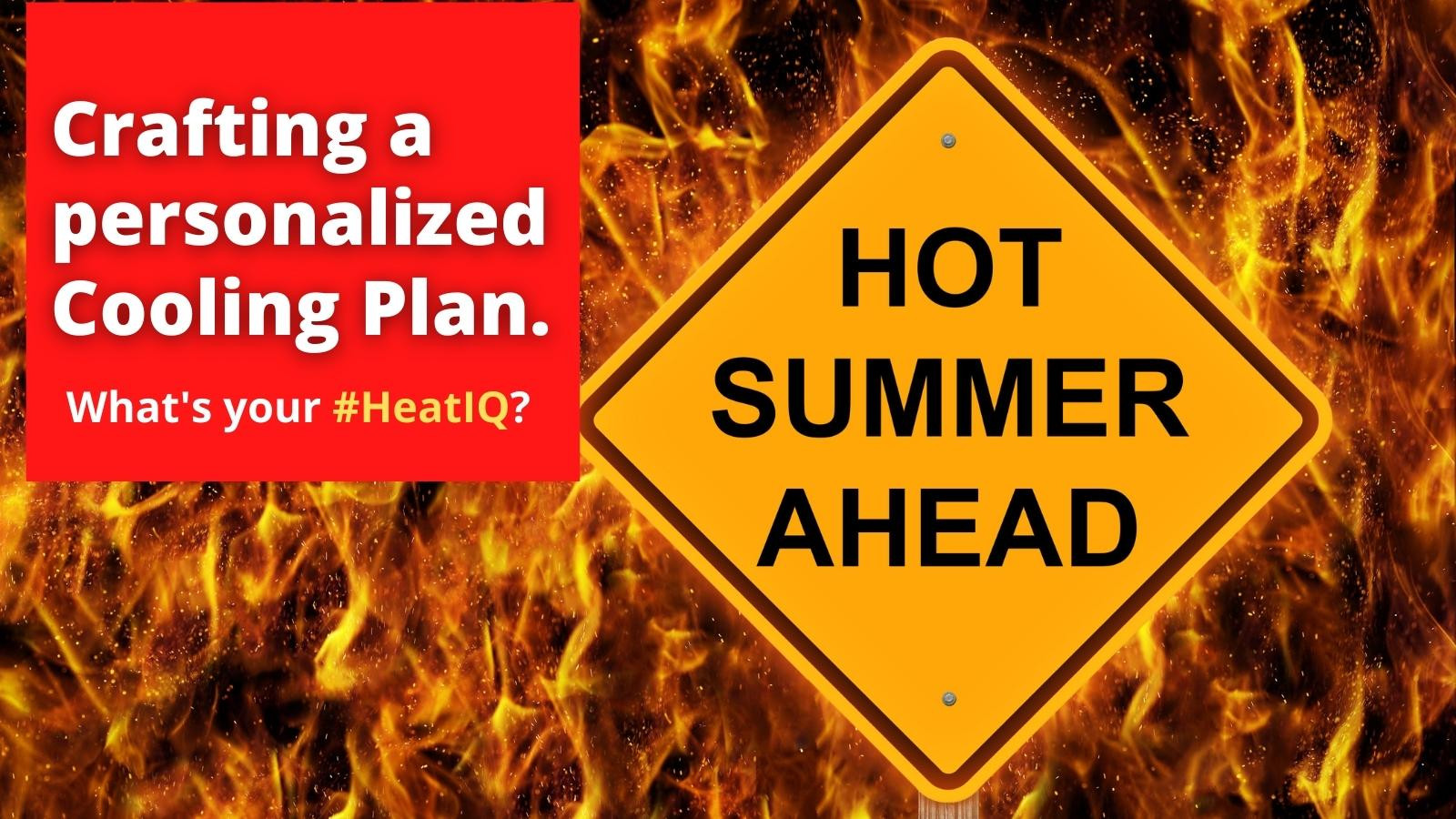July 6, 2023
The dog days of summer with scorching temperatures and high humidity can be a killer. More than 1,300 people die and tens of thousands are sickened each year in the U.S., often from heatstroke, which occurs when the body’s temperature reaches 104° F or higher
Often people don’t realize how dangerous extreme heat can be. Heat can affect anyone and simple precautions can help keep you safe. Here's how to protect yourself.
Know the Lingo
Have you heard or read about one or more kinds of temperature cautions? What do all those cautions mean? We’ve decoded them below but keep in mind that definitions may vary by area.
- Heat Index: A measure of how hot it feels outside based on temperature and humidity. The latter is key: The more humid the air is, the longer it takes for sweat to evaporate and help you cool down.
- Excessive Heat Outlook: A heat wave is expected within three to seven days.
- Excessive Heat Watch: Conditions are ripe for a heatwave within one to three days.
- Heat Advisory*: A maximum heat index temperature of 100° F or more, with nighttime temperatures of 75° F or higher, is expected within 12 hours and to last at least two days.
- Excessive Heat Warning*: Extremely dangerous heat conditions. A maximum heat index temperature of 105° F or more for at least two days, with nighttime temps 75° F or higher expected within 12 hours.
- Heat wave (or excessive or extreme heat): Abnormally hot (and possibly humid) weather for the time of year and area that typically lasts longer than two days.
*It’s important to prepare for these high-heat situations by ensuring that you‘ll have a place to stay cool and access to plenty of liquids to help you stay hydrated. To get forecasts for your area, go to weather.gov and type in your ZIP code.
Look at Heat AND Humidity
- There’s no temperature that’s considered the threshold for danger because humidity also plays a huge part
- Check the Heat Index. It’s a measure of how hot it feels outside based on temperature and humidity. The latter is key: The more humid the air is, the longer it takes for sweat to evaporate and help you cool down.
- To get heat and humidity information and forecasts for your area, check your local news or go to weather.gov and type in your ZIP code.
Take Steps to Stay Cool
- Dress in lightweight, light-colored, breathable clothing. Cotton and linen reflect heat instead of absorbing it and permit perspiration to evaporate.
- Ad a Cooling Vest to help keep your core temperature in the safe zone. ThermApparel’s UnderCool Cooling Vests give you the flexibility of refreezing your cooling packs in the fridge, freezer, or ice water. This is especially helpful if the electricity goes out.
- Outdoors, wear a wide-brimmed hat and apply sunscreen with an SPF of at least 30; SPF 50 is better. Reapply every 2 hours and immediately after swimming or sweating. Sunburn can hinder your body’s ability to cool itself.
- On humid days, take it easy with outdoor physical activity. Leave major outdoor projects until the heat wave breaks. Do vigorous activity during the coolest parts of the day. Early morning is best because the heat of the day can be slow to dissipate in the evening.
- If your area is experiencing extreme heat, stay in air-conditioned spaces as much as possible, especially during the warmest parts of the day, typically 10 a.m. to 5 p.m.
- Watch out for hot-car hazards. A car’s interior can heat up by 40° F within an hour, which can lead to dangerous or even deadly temperatures. Never leave anyone or pets unattended inside a vehicle. Use a back seat reminder by placing a diaper bag or leash on the front seat to reduce the risk that someone will be left in a vehicle on a hot day.
Have a Splashing Good Time
- Take a dip on a blistering-hot day to deliver a double dose of relief. You will feel cooler while swimming, and the evaporation of the water on your skin afterward will chill you further.
- Take a cool bath or shower, wipe a damp cloth over your skin, spritz yourself with cool water from a mister, or dunk your hat in water before putting it back on your head can lower your body temperature.
- For a quick chill, place a cool, damp cloth or your ThermApparel Cooling Packs on pulse points like your armpits, forehead, and the back of your neck. This helps cool the blood circulating throughout your body which cools your entire body down.
- But be cautious about ice baths or using ice packs on pulse points for prolonged periods. You may cool yourself too much, causing you to shiver, which is your body’s attempt to generate heat—the opposite of what you want.
••Please note: ThermApparel Cooling Packs are not ice packs. They are PCM (Phase Change Material) Cooling Packs and are designed to melt and refreeze at 70F. This makes them safe to leave on your pulse points like your armpits, forehead, and the back of your neck. But if you do start to shiver because you have cooled down enough remove the cooling packs from your pulse points.
Stay Well-Hydrated
- Drink up. Many of us don’t drink enough liquids when temperatures climb, and dehydration can increase the risk of dangerous heatstroke. During heat advisories, you need to drink more water than you think.
- A cup of water every 90 minutes while you’re awake is a good start. If you’re outside in the heat working or exercising, ramp that up to a cup every half-hour. And if you aren’t urinating much, at least once every 4 hours, drink more. Thirst isn’t really a reliable indicator because, by the time you feel thirsty, you’re already somewhat dehydrated.
- Do you need help to hydrate as much as you probably should? Set alerts on your phone as a reminder. Sipping small amounts of liquids throughout the day, adding slices of citrus to a pitcher of water, and eating high-water foods such as fruit can also help you get enough liquid when the heat is on.
- During a heat wave take water with you wherever you go. Try an insulated water bottle. Cool liquids feel good going down, and research shows that they can also help reduce your core body temperature. Water that’s cool—50° F to 60° F—but not ice-cold is optimal for hydration.
- If you notice signs of dehydration, including increased thirst, dry mouth, and tongue, restlessness or irritability, decreased urine, or skin slow to move back into place when pinched, drink more fluids right away. If you’re producing very dark urine, contact a doctor.
Use the Buddy System
- Certain groups of people are more prone to heat-related problems. They include older adults and young children, whose bodies aren’t as adept at regulating their temperature, and people with certain chronic medical conditions, including diabetes and cardiovascular disease.
- Those who have asthma or chronic obstructive pulmonary disease might experience more breathing problems in the extreme heat and should watch the forecast for air-quality advisories along with extreme heat events. To get forecasts for your area, go to airnow.gov and type in your ZIP code.
- Certain medications, including diuretics, can also hike the risk of heat-related illnesses.
- If you have older relatives or neighbors, call or stop by to check on them frequently during a heat wave. And never leave an infant or child or a pet alone in a hot car, even for a few minutes. If you have a child or pet in the back seat, keep a visual reminder of his or her presence in the front seat, such as a diaper bag or leash.
Know the Signs of Heat-Related Illness
Here’s what to look for and what to do:
- Heat Cramps: These painful muscle cramps are often a result of a lot of strenuous activity in the heat. Drinking water and juice or a sports drink to replenish lost fluid and salt, and resting for a few hours, can help.
- Heat Exhaustion: Signs of heat exhaustion include feeling tired, weak, or dizzy; sweating heavily; nausea and vomiting; and pale skin. If you notice any of these symptoms, stop what you’re doing, rest, hydrate, and try to cool your body down by getting into air conditioning if you can, or taking a cool bath or shower. If left untreated, heat exhaustion can progress to heat stroke.
- Heat Stroke: This condition, which can be fatal, occurs when your body’s mechanism for cooling itself becomes overwhelmed and your temperature rises to 104° F or higher. Signs include confusion or an altered mental state, nausea, red and hot skin, being unable to sweat, a throbbing headache, and/or fainting.
Here’s what to do for heat stroke, call 911 immediately and begin to try and cool down. Place a cool, damp cloth or your ThermApparel Cooling Packs on pulse points like your armpits, forehead, and the back of your neck. This helps cool the blood circulating throughout your body. Spray down with a garden hose, get into a cool shower, sponge down with cool water, or submerge parts of your body in ice water.
Keep Your Home Comfortable
Keep your rooms cool.
- Close blinds, drapes, and shades. Keep the lights off or swap heat-emitting incandescent light bulbs for LEDs or CFLs. Routinely clean or replace your air conditioner filters.
- Don’t underestimate how hot it can get indoors without AC. Heat conditions indoors have the potential to reach a heat index of at least 93° F during heat waves which is a dangerous level.
- When AC at home isn’t an option, air-conditioned public spaces, such as movie theaters and libraries, can offer relief. Check with your local public health department about whether any cooling centers (air-conditioned spaces open to the public) are available in your area.
Stop Heat From Building Up
- Seal hot air out. Caulk and weather strip doors and windows. Block the sun. Close blinds, drapes, and shades, especially when the sun is hitting them. Stick-on reflective/solar-blocking window film or mesh solar window screens also cut heat and glare.
- Avoid running your clothes dryer or oven, and use the cold-water setting on your washing machine and the air-dry setting on your dishwasher. For cooking, a multi-cooker, microwave, and/or toaster oven won’t heat up the kitchen the way your oven will.
Try Low-Tech Cooling Tactics
- Flip a fan on. Fans can offer relief 95 percent of the time when the temperature is between 98.6° F and 102.2° F.. A ceiling fan can make the temperature feel up to 4° F chillier.
- Window fans typically pull outside air in and circulate it, so they may be most effective at night.
- Make a little room cooler with a fan and a bowl of ice. Place the bowl of ice in front of the fan’s airway.
Optimize Your Air Conditioning
- Place window units in north-facing or shaded windows.
- Keep heat-emitting objects such as computers, TVs, and lamps out of the line of the unit’s airflow.
- Vacuum window unit filters every couple of weeks, wash the filters with warm water and soap at least every two months, and replace the filters when they’re worn.
- For a whole-house system, a licensed, certified air conditioner contractor can check it every year to make sure your air conditioner or heat pump system is running well.
#HeatIQ - Crafting a Personalized Cooling Plan Blog Series
Dive into the science of how our bodies deal with heat and heat sensitivity, how different environments require different strategies for cooling, and the many strategies available to reduce the risk of heat so you can improve your #HeatIQ and make a plan to keep doing the things you love



